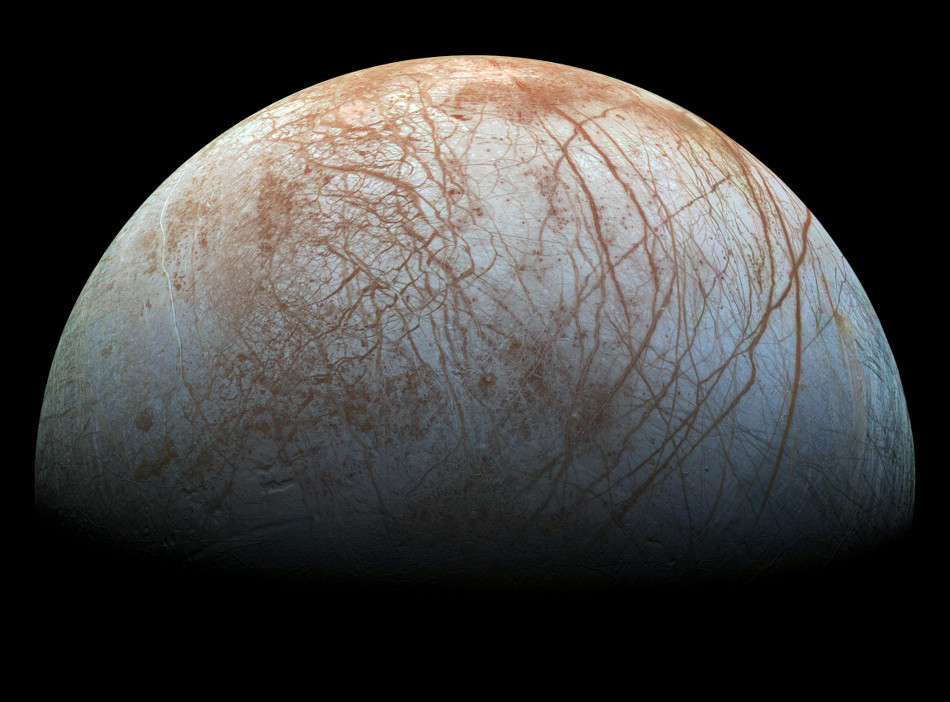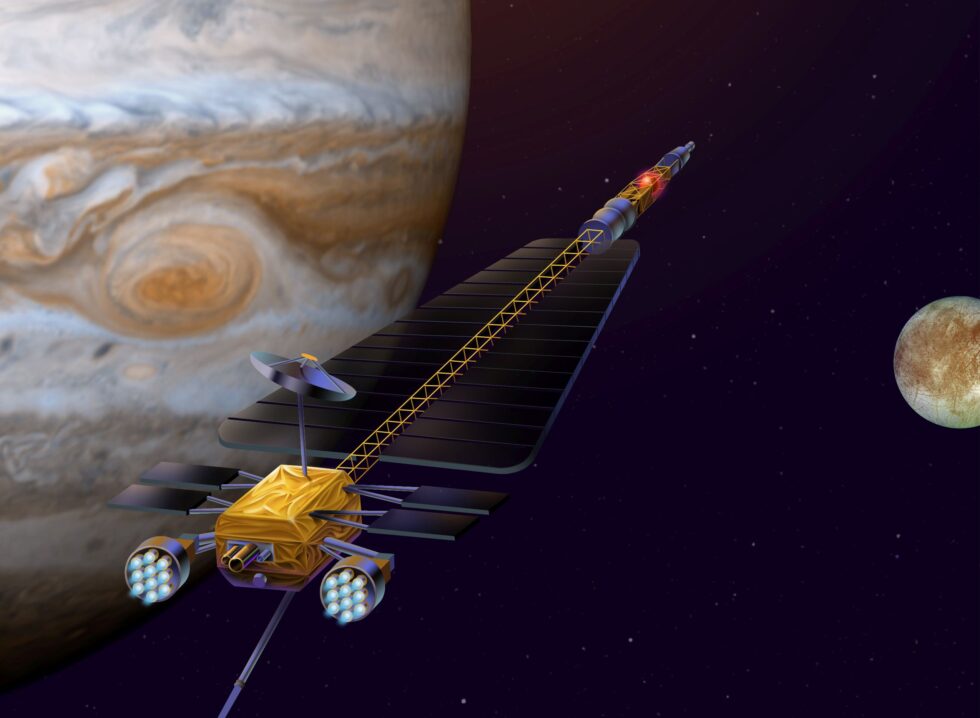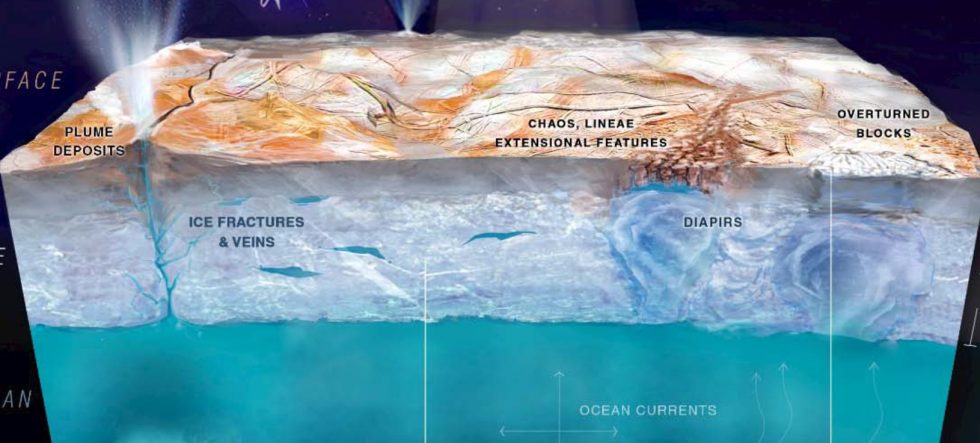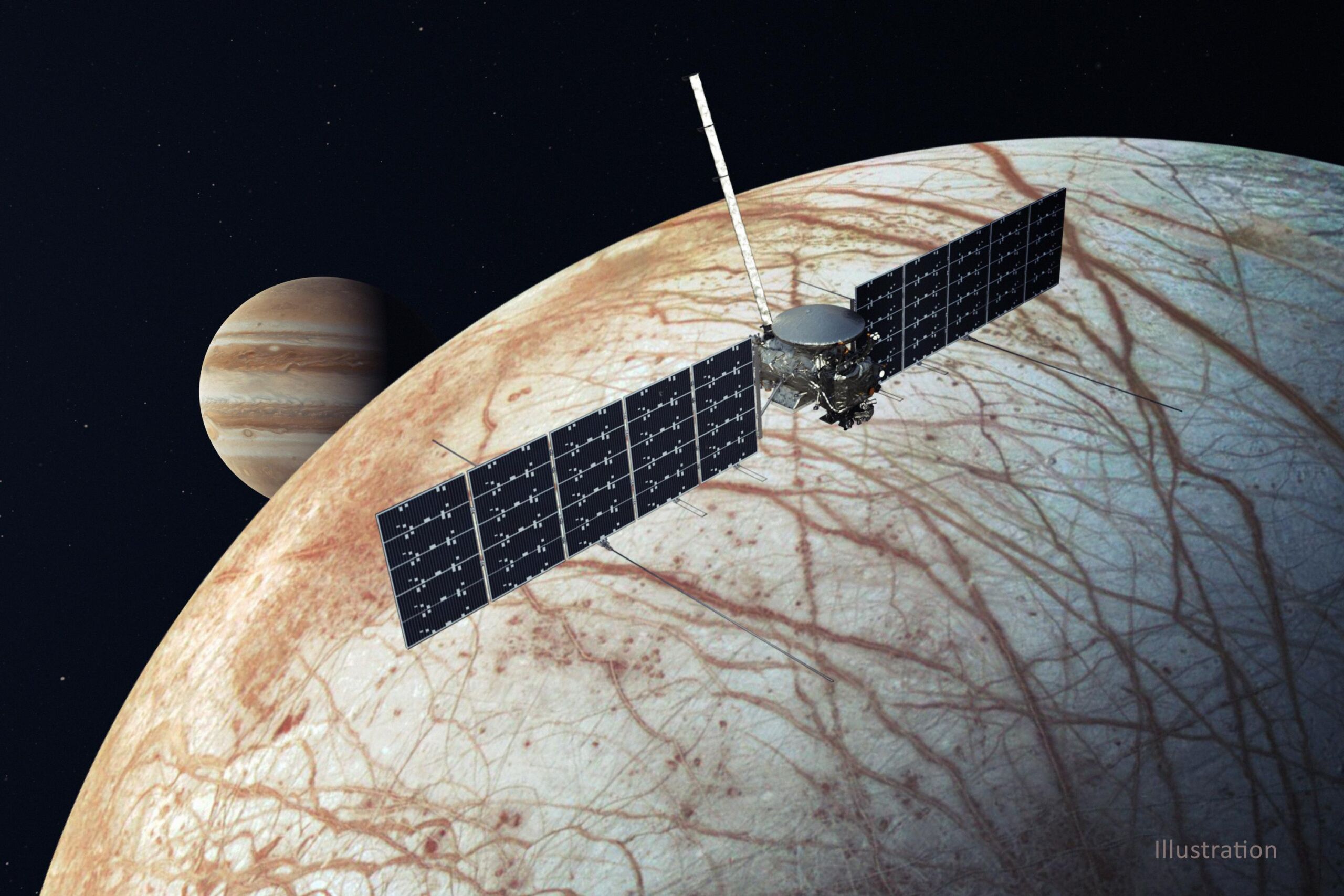If you've been waiting for a real mission of discovery into the unknown, this is it.

The icy surface of Europa could hide life below.
Credit: NASA
I really hate to be the bearer of such bad news, but you and I will not live forever, dear reader.
We may hope to draw breath for a few decades yet, perhaps. But that's not long enough to descry any worlds circling other stars in a meaningful way. Those mysterious orbs are too distant, both in space and time; the vastness of this galaxy is too great, the beat of a human life too short against the slow rhythm of cosmic time. We space enjoyers must therefore be content with what lies in our backyard.
If you are of a certain age, say half a century old or less, you may feel as though you missed the golden age of space exploration, when humanity first walked into that backyard. The Baby Boomers, who were born in time to not only see what the lunar surface looked like but to watch humans walk upon it in real time, were truly lucky.
What an era that was! Before then, everything but the Sun and Moon were dots in the nighttime sky. In 1962, Mariner 2 revealed Venus for the first time. Mariner 4 flew by Mars a couple of years later. Then there were the Voyagers, which passed by Jupiter in 1979, Saturn in 1980 and 1981, Uranus in 1986, and Neptune in 1989. And don't forget the Viking landers in the mid-1970s, which proved the non-existence of little green men on Mars. The Boomers got to see all of this, unwrapping the Solar System, one greatest hit at a time.
But if you weren't there, don’t despair. In the last decade or so, we’ve started to open some wild new frontiers. A decade ago, Europe’s Rosetta spacecraft provided unparalleled images of a comet, and then its tiny Philae lander flew down to the surface and revealed a winter-like wonderland. The next year, NASA’s New Horizons spacecraft flew by Pluto and its moon Charon and revealed all manner of wonders, including—for real—ice volcanoes.
And these recent treats are but appetizers for the greatest undiscovered world in our Solar System left to be explored, a place that harbors dark mysteries we can presently only blindly stab at with blunt knives. I am speaking, of course, of Jupiter’s ice-encrusted moon Europa. Beneath a thick sheet of ice lies a vast, warm ocean. Scientists believe conditions at the bottom of this immense global sea are not unlike those near hydrothermal vents on the seabed of Earth’s oceans, where life on our planet may have originated. We can only guess at basic questions, like how thick is the ice? How deep is the ocean? What secrets are there to be plumbed in its dark depths? Could marine life really exist there?
The magic of this moment is that we are finally going. If you wanted to be alive for a real mission of discovery to an unknown but tantalizing world, this is it.
As soon as this weekend, a Falcon Heavy rocket will lift off, carrying the $4.25 billion Europa Clipper spacecraft. This mission is unlikely to definitively answer the question of whether life exists in the oceans below, but it will tell us whether it could, and it will answer so many more questions about the icy moon. The best part is the unknown wonders it will discover. We cannot begin to guess at those, but we can be certain that if all goes well, Clipper will be a thrilling and breathtaking mission.
And it very nearly did not happen. That's the story I want to tell here.
It all began decades ago
After the two Voyager flybys in 1979, NASA sent a dedicated probe named Galileo to Jupiter in the 1990s. This spacecraft made several passes by Europa during its nearly eight years in orbit around Jupiter, and data from this mission indicated the likely presence of a water ocean beneath the moon's icy surface. In the nearly three decades since then, planetary scientists have had little more to go on than these tantalizing clues. They've desperately wanted to know more.
Almost immediately after the first Europa data from Galileo beamed back to Earth in 1996, the administrator of NASA at the time, Dan Goldin, asked scientists at the agency's Jet Propulsion Laboratory in California whether a small mission dedicated to the study of Europa was possible. Fitting within Goldin's ethos of "faster, better, and cheaper," he wanted a design for a spacecraft carrying just 27 kg of scientific instruments to Europa, about the same mass as a suitcase than can be checked on to an airplane.
"That was the beginning of a Europa orbiter concept," said science writer David Brown, author of The Mission, which tells the definitive story of the Europa Clipper mission.
The original science objectives outlined during the development of this orbiter mission—to investigate the composition of Europa’s ice shell and ocean, the world's geology, and to search for and characterize any plumes emanating from the ocean below—remain more or less the same with Clipper. However, as often happens with deep space missions, the budget doubled. NASA's chief of science at the turn of the century, astrophysicist Ed Weiler, killed the nascent Europa program.
But scientists were still interested. In 2003, the National Research Council published its first "decadal survey," a process by which the scientific community outlines research priorities for NASA. Over the years, these decadal surveys have become influential tools for guiding NASA policy. In this first survey, scientists recommended that NASA establish a "large-class" mission to study Europa.

The NASA administrator at the time, Sean O'Keefe, sought to develop a new generation of spacecraft powered by nuclear reactors as part of what he called Project Prometheus. He believed that a mission with Europa as its main target offered a perfect test case for the technology, and thus, the Jupiter Icy Moons Orbiter was born. This was a highly ambitious mission. A typical spacecraft uses on the order of a few hundred watts of power. This probe, powered by a nuclear reactor, would have had on the order of 100,000 watts of power.
The Jupiter Icy Moons Orbiter was audacious in other ways, such as using a landing component to directly sample Europa's ice. Unfortunately, the mission also became insanely expensive, with a budget blasting past $20 billion. When O'Keefe was replaced by a new administrator in 2005, Mike Griffin, the Jupiter Icy Moons Orbiter was put on ice.
Galileo sparked an incredible amount of interest in Europa. First, NASA tried a fast, cheap mission. Then the agency worked on the most ambitious spacecraft concept ever put forward. Both failed. A decade was lost.
A new champion emerges
In 2000, a conservative Texas attorney named John Culberson won election to the US House of Representatives for the first time. For a time, he focused on local issues, such as freeway construction in the greater Houston area. However, after the cancellation of the Jupiter Icy Moons Orbiter, he was furious.
Most people in Congress, to the extent they care about NASA, do so for parochial interests and local jobs. For Culberson, that meant Johnson Space Center, which was located in a district adjacent to his. But Culberson was also deeply interested in planetary exploration, and he wanted to be associated with NASA's first mission to find life on another world. So he became an advocate of funding for a NASA center on the opposite side of the country, the Jet Propulsion Laboratory, which led the agency's robotic exploration efforts.
As a member of the House Appropriations Committee, Culberson began to tuck funding into NASA's budget for the ongoing study of a Europa orbiter.
During this period, as a science reporter for the Houston Chronicle, I began to bump into Culberson at various events around town. He was both a conservative Christian politician and a life-long science geek. Skeptic that I am, I wondered if his interest in science was an act to ingratiate himself with constituents, given that the Houston area has a large biomedical community. Eventually, however, I began to realize it was totally genuine. He is fascinated by the Solar System and wants to know more about its origin and whether it harbors life on worlds other than Earth. We bonded over this mutual interest.
In the meantime, there were more furtive starts on a Europa mission. In 2007, NASA began studying mission concepts for Europa and Ganymede in the Jovian system, as well as the moons Titan and Enceladus around Saturn. Working with international partners two years later, NASA eventually down-selected to a combination mission in which the US space agency built an orbiter for Europa and the European Space Agency one for Ganymede (eventually, this European mission did launch, as JUICE, in 2023). NASA's part was known as the Jupiter Europa Orbiter.
However, a year later, new NASA Administrator Charles Bolden was looking for ways to cut the agency's budget. By now, you probably know what was about to happen. Sure enough, the Jupiter Europa Orbiter's budget was ballooning to above $3 billion. And there was another problem—Mars became ascendant in the agency's exploration interests.
"For the first time in 20 years, Mars was brought into competition with the outer planets," Brown said. "The top endorsement in a painful budget environment was a Mars Sample Return. As a result, the Jupiter Europa Orbiter died."
Once again, Culberson was not happy. But this time, he would soon be in a position to do something about it.
Going behind the curtain
In 2012, NASA initiated a new series of studies to yet again define a Europa mission. The leading contender that emerged from this process was a spacecraft capable of making multiple flybys of the Jovian moon, and this became known as the Europa Clipper. Scientists realized it was impractical to build an orbiter because the spacecraft would have a short lifetime due to constant exposure to the intense radiation emanating from Jupiter. By making dozens of flybys, Clipper could swoop into the inner Jovian system, gather data from Europa, and then transmit it back to Earth when the spacecraft was further from Jupiter's harsh radiation environment.
Starting in fiscal year 2013, Culberson began adding money to NASA's budget specifically for the development of a Clipper mission, even though NASA had not committed to starting a program.
"We're only going to have one chance at this in our lifetimes," he told me that year, explaining his effort to essentially force NASA to green-light a Europa mission after nearly two decades of dithering. "We've got one shot. I want to make sure you and I are here to see those first tube worms and lobsters on Europa."
NASA could not afford to ignore Culberson, who was no longer a junior Congressman. In December 2013, U.S. Rep. Frank Wolf, a Virginia Republican, said he would not run for re-election in 2014, leaving Culberson as the odds-on favorite to replace him as chairman of an appropriations subcommittee that oversees NASA. Effectively, this gave Culberson control over the agency's purse strings.
In January 2015, that happened. Now chairman of the all-important budget subcommittee, Culberson began making periodic trips to the Jet Propulsion Laboratory in California. To the mortification of NASA's senior leaders and communications officials, Culberson decided to invite me to come along for sessions that would last a day or two. There were no restrictions. I got to sit in on all the meetings, hear the discussions, and even participate at times. Even better, at Culberson's insistence, it was all on the record.
Let me explain how rare an opportunity this is. Typically, journalists learn about space exploration by interviewing sources, attending press conferences, and reading scientific papers. But to be in the room where it happened? That just does not happen. But Culberson was inviting me behind the curtain into detailed discussions where the mission planners and leadership at the NASA facility in California explained what they were doing, why they were doing it, and where they needed political help. It was eye-opening for me to see how these kinds of missions got done and see power in action.

During these meetings, Culberson—universally referred to as "Mr. Chairman" during these visits—would make suggestions and push the scientists to be bold in their design and instrument choices. He would always ask how much funding they needed and then deliver that during the next budget cycle. All of this was happening, more or less, because Culberson felt Clipper was important for the nation.
Eventually, NASA leadership bowed to the inevitable and made a formal commitment to the Clipper mission. No longer did Culberson have to include language in budget requests such as "NASA shall fund" the Clipper, as the agency was on board. By the time Culberson lost re-election in 2018—a midterm election when Democrats gained seats in response to the unpopular first term of former President Donald Trump—Clipper was far enough along to be secure.
A lot of people bear responsibility for creating Clipper concepts and keeping the idea alive at the Jet Propulsion Laboratory and at NASA's headquarters in Washington D.C., Brown said. These include scientists and leaders such as Charles Elachi, Karla Clark, Bob Pappalardo, Louise Proctor, and Curt Niebur. But Culberson stands alone for getting the mission done.
“Without John Culberson, none of this would have ever happened," Brown said. "If you want to boil it down to dollars and cents, he’s the man who paid for this thing and got it far enough down the road that it was going to fly."
What Clipper will do
Clipper's launch on a fully expendable Falcon Heavy rocket, unfortunately, only marks the end of the beginning for the mission. It will take 5.5 years for the spacecraft to reach the Jupiter system. During that time, the spacecraft will traverse a mind-bending 1.8 billion miles (2.9 billion kilometers).
Once it arrives at Jupiter, the spacecraft will make 80 orbits of Jupiter, including 49 flybys of Europa. On some of these passes, the spacecraft will come to within 15 miles (25 km) of the moon's surface, providing us an incredible view of the ice and any plumes.
Plumes, of course, would be incredibly exciting because they would offer direct evidence of what the subsurface ocean is like. There is some piecemeal evidence from Galileo, as well as observations by the Hubble Space Telescope, that such plumes may be breaking through ice through fissures. But we just don't know for sure.
Clipper is the largest spacecraft humans have ever launched into deep space. It never got that nuclear power source, so it has massive solar arrays that are 45 feet (14 meters) long and 15 feet (4.5 meters) tall. You could comfortably play a game of pick-up basketball on a court that size.
The spacecraft carries a sophisticated suite of instruments, including a powerful ice-penetrating radar that will study the interface between the icy crust and ocean and possibly identify pond or lake-like features there.
Although this is not a life-detection mission, scientists could get really lucky and find the signatures of life in a plume or on the surface. In all likelihood, however, they will simply characterize the world and its ocean, with the intent of coming back in the (distant) future with a lander to make in-situ measurements and possibly detect life.
Most exciting of all, however, is that Clipper truly is flying into the unknown. This is a mission of pure discovery to one of the most exciting worlds near Earth. Whenever we explore a new place in space, nature always surprises us. "We have always uncovered things that we could not imagine," Bonnie Buratti, the deputy project scientist for Clipper, said during a recent briefing. Indeed.
Europa has many secrets, and we're finally coming for them.
RIP Matrix | Farewell my friend ![]()
Hope you enjoyed this news post.
Thank you for appreciating my time and effort posting news every day for many years.
2023: Over 5,800 news posts | 2024 (till end of September): 4,292 news posts



3175x175(CURRENT).thumb.jpg.b05acc060982b36f5891ba728e6d953c.jpg)
Recommended Comments
There are no comments to display.
Join the conversation
You can post now and register later. If you have an account, sign in now to post with your account.
Note: Your post will require moderator approval before it will be visible.